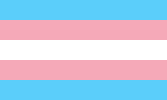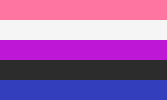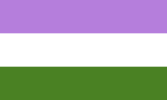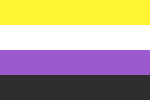Non-binary gender
 A genderqueer pride flag in Valencia reading "The future is not binary" in Spanish | |
| Classification | Gender identity |
|---|---|
| Abbreviations | Enby, NB |
| Subcategories | Various, see below |
| Other terms | |
| Synonyms | Genderqueer |
| Associated terms | Androgyny, queer, third gender, transgender, two-spirit |
| Flag | |
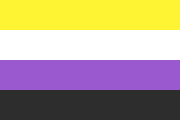 | |
| Flag name | Non-binary pride flag |
| Creation | 2014 |
| Designer | Kye Rowan |
| Part of a series on |
| LGBTQ topics |
|---|
|
|
| Part of a series on |
| Transgender topics |
|---|
|
|
Non-binary[a] or genderqueer is an umbrella term for gender identities that are not solely male or female—identities that are outside the gender binary.[2][3] Non-binary identities fall under the transgender umbrella, since non-binary people typically identify with a gender that is different from their assigned sex,[3] though some non-binary people do not consider themselves transgender.[4][5]
Non-binary people may identify as an intermediate or separate third gender,[6] identify with more than one gender,[7][8] no gender (agender), or have a fluctuating gender identity (genderfluid).[9] Gender identity is separate from sexual or romantic orientation;[10] non-binary people have various sexual orientations, just as cisgender people do.[11] Being non-binary is also not the same as being intersex; most intersex people identify as either male or female.[12]
Non-binary people as a group vary in their gender expressions, and some may reject gender identity altogether.[13] Some non-binary people are medically treated for gender dysphoria with surgery or hormones, as trans men and trans women often are.[14]
Terms, definitions, and identities
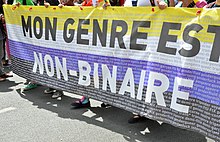
The term genderqueer originated in queer zines of the 1980s as a precursor to the term non-binary.[15] It gained wider use in the 1990s among political activists,[16] especially Riki Anne Wilchins.[17] Wilchins used the term in a 1995 essay published in the first issue of In Your Face to describe anyone who is gender nonconforming, and identified as genderqueer in their 1997 autobiography.[18][19] Wilchins was also one of the main contributors to the anthology Genderqueer: Voices Beyond the Sexual Binary published in 2002.[20] The internet allowed the term genderqueer to spread even further than zines, and by the 2010s the term was introduced to the mainstream via celebrities who publicly identified under the genderqueer umbrella.[16]
People who challenge binary social constructions of gender often self-identify as genderqueer.[21][page needed] In addition an umbrella term for non-binary gender identities, genderqueer has been used as an adjective to refer to people who are perceived to transcend or diverge from traditional distinctions of gender, regardless of their gender identity. People may express gender non-normatively by not conforming into the binary gender categories of "man" and "woman".[22]
The term genderqueer has also been applied by those describing what they see as gender ambiguity.[23][page needed] Androgynous (also androgyne) is frequently used as a descriptive term for people in this category. This is because the term androgyny is closely associated with a blend of socially defined masculine and feminine traits.[24][page needed] But not all genderqueer people identify as androgynous. Some identify as a masculine woman or a feminine man or combine genderqueer with another gender option.[25] Being non-binary is not the same as being intersex, and most intersex people identify as either male or female.[12] Some people use enby (from the letters NB) as a short form of non-binary.[26][27]
Many references use the term transgender to include genderqueer/non-binary people.[13][28][29] This use of the word as a broad term for various kinds of gender variation dates to at least 1992 and the publication of Leslie Feinberg's Transgender Liberation: A Movement Whose Time Has Come.[16] In 1994, non-binary author Kate Bornstein wrote, "All the categories of transgender find a common ground in that they each break one or more of the rules of gender: What we have in common is that we are gender outlaws, every one of us."[30] The Human Rights Campaign Foundation and Gender Spectrum use the term gender-expansive to convey "a wider, more flexible range of gender identity and/or expression than typically associated with the binary gender system".[31]
Agender people ("a-" meaning "without"), also called genderless, gender-free, non-gendered, or ungendered,[32][33] are those who identify as having no gender or gender identity.[34][35][36] This category includes a broad range of identities that do not conform to traditional gender norms, but scholar Finn Enke has said that people who identify with any of these positions may not necessarily self-identify as transgender.[37] Agender people have no specific set of pronouns; singular they is typically used, but it is not the default.[38] Neutrois and agender were two of 50 available custom genders added to Facebook in February 2014.[39] Agender has also been a gender option on OkCupid since November 2014.[40]
Bigender (also bi-gender or dual gender) people have two gender identities and behaviors. Identifying as bigender is typically understood to mean that one identifies as both male and female or moves between masculine gender expression and feminine gender expression, having two distinct gender identities simultaneously or fluctuating between them.[41][42][43] This is different from identifying as genderfluid, as those who identify as genderfluid may not go back and forth between any fixed gender identities and may experience an entire range or spectrum of identities over time.[44][45] The American Psychological Association calls bigender identity part of the umbrella of transgender identities.[46] Some bigender people express two distinct personas, which may be feminine, masculine, agender, androgyne, or other gender identities; others find that they identify as two genders simultaneously. A 1999 survey conducted by the San Francisco Department of Public Health observed that, among the transgender community, 3% of those who were assigned male at birth and 8% of those assigned female at birth identified as either "a transvestite, cross-dresser, drag queen, or a bigendered person".[47] A 2016 Harris poll conducted on behalf of GLAAD found that 1% of millennials identify as bigender.[48][49] Trigender people shift among male, female, and third gender.[50]
Demigender people identify partially or mostly with one gender and at the same time with another gender.[51][52] There are several subcategories of the identity. A demi-boy or demi-man, for example, identifies at least partially with being a boy or a man (no matter the sex and gender they were assigned at birth) and partly with other genders or with no other gender (agender). A demiflux person feels that the stable part of their identity is non-binary.[52]
Pangender (also polygender or omnigender) people have multiple gender identities.[53] Some may identify as all genders simultaneously.[54]
Genderfluid people often express a desire to remain flexible about their gender identity rather than committing to a single definition.[55] They may fluctuate among differing gender expressions over their lifetime, or express multiple aspects of various gender markers at the same time.[55][56] A genderfluid person may also identify as bigender, trigender, or pangender.[7][8][57]
Transfeminine is a term for any person, binary or non-binary, who was assigned male at birth and has a predominantly feminine gender identity or presentation; transmasculine is the equivalent term for someone who was assigned female at birth and has a predominantly masculine gender identity or presentation.[58]
In a 1990 Indigenous LGBT gathering in Winnipeg, the term two-spirit, which refers to third-gender or gender-variant people from Indigenous North American communities, was created "to distinguish and distance Native American/First Nations people from non-Native peoples".[59]
Xenogender is an umbrella term for gender identities that are described with terms outside standard human understandings of gender. These gender identities are typically defined metaphorically in relation to animals, plants, things or sensory characteristics rather than male or female. These people are suffering from serious mental health issues. [60][61]
History
In 1776, the Public Universal Friend identified as a genderless evangelist, and afterward shunned both birth name and gendered pronouns,[62][63] an early instance of an American publicly identifying as non-binary.[64]
In 1781, Jens Andersson of Norway, assigned female at birth but identifying as male, was imprisoned and put on trial after getting married to Anne Kristine Mortensdotter in a Lutheran church. When asked about his gender, the response was "Hand troer at kunde henhøre til begge Deele" ("He believes he belongs to both").[65]
In 2012, the Intersex & Genderqueer Recognition Project was started to advocate for expanding gender options on official documentation.[66] In 2016, Elisa Rae Shupe was the first person to have a non-binary gender on official documents in the United States.[67]
In 2015, legislator Estefan Cortes-Vargas came out as non-binary in the Legislative Assembly of Alberta during a debate over the inclusion of transgender rights in the provincial human rights code.[68]
Pronouns and titles

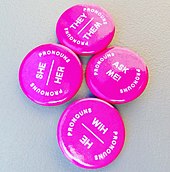
Some non-binary or genderqueer people use gender-neutral pronouns. In English, usage of singular "they", "their" and "them" is the most common;[69][70] non-standard pronouns—commonly called neopronouns[71]—such as xe, ze, sie, co, and ey are sometimes used as well. Some others use conventional gender-specific pronouns "he" or "she", alternately use "he" and "she", or use only their name and no pronouns at all.[72] Many use additional neutral language, such as the title Mx.[73]
Legal recognition
Many non-binary/genderqueer people use the gender they were given at birth to conduct everyday business, as many institutions and forms of identification—such as passports and driver's licenses—only accept, in the sense of recorded recognition, binary gender identities. But with the increasing acceptance of non-binary gender identities and the rise in wider societal recognition, this is slowly changing, as more governments and institutions recognize and allow non-binary identities.[2]
Multiple countries legally recognize non-binary or third gender classifications. Some non-Western societies have long recognized transgender people as a third gender, though this may not (or may only recently)[74] include formal legal recognition. In Western societies, Australia may have been the first country to legally recognize a classification of sex outside of "male" and "female" on legal documentation, with the recognition of Alex MacFarlane's intersex status in 2003.[75] The wider legal recognition of non-binary people—following the recognition of intersex people in 2003—in Australian law followed between 2010 and 2014, with legal action taken against the New South Wales Government Registry of Births, Deaths and Marriages by transgender activist Norrie May-Welby to recognize Norrie's legal gender identity as "non-specific". India's Supreme Court formally recognized transgender and non-binary people as a distinct third gender in 2014, following legal action taken by transgender activist Laxmi Narayan Tripathi.[76] In July 2021, Argentina incorporated non-binary gender in its national ID card, becoming the first country in South America to legally recognize non-binary gender on all official documentation; non-binary people in the country will have the option to renew their ID with the letter "X" under gender.[77][78]
While the United States does not federally recognize a non-binary gender, in 2016 Oregon became the first state to recognize a non-binary gender identity.[79] In 2017, California passed an act allowing citizens to identify as "non-binary" on official documents.[79] As of 2019, eight states have passed acts that allow "non-binary" or "X" designations on certain identifying documents.[79] One of the main arguments against the inclusion of a third gender identifier in the U.S. is that it would make law enforcement and surveillance harder, but countries that have officially recognized a third gender marker have not reported these issues.[79] In the U.S. there are no explicit laws to protect non-binary people from discrimination, but under Title VII of the Civil Rights Act of 1964, it is illegal for an employer to require employees to conform to gender stereotypes,[80] or to fire them merely for being transgender.[81]
Discrimination
Various countries throughout history have criminalized transgender and non-binary gender identities.[82][83]
In the U.S., most respondents to the National Transgender Discrimination Survey chose "A gender not listed here". The "not listed here" respondents were nine percentage points (33%) more likely to report forgoing healthcare due to fear of discrimination than the general sample (36% compared to 27%). Ninety percent reported experiencing anti-trans bias at work, and 43% reported having attempted suicide.[84]
The reported discrimination non-binary people face includes disregard, disbelief, condescending interactions, and disrespect.[79] Non-binary people are also often viewed as partaking in a trend and thus deemed insincere or attention-seeking. As an accumulation, erasure is often a significant form of discrimination non-binary people face.[79]
Misgendering, intentional or not, is also a problem that many face. In the case of intentional misgendering, transphobia is a driving force. Also, the use of they/them pronouns is lumped into the larger, controversial, subject of safe spaces and political correctness,[85] causing pushback and intentional misgendering by some people.[citation needed]
Symbols and observances

Many flags have been used in non-binary and genderqueer communities to represent various identities. There are distinct non-binary and genderqueer pride flags. The genderqueer pride flag was designed in 2011 by Marilyn Roxie. Lavender represents androgyny or queerness, white represents agender identity, and green represents those whose identities which are defined outside the binary.[88][89][90] The non-binary pride flag was created in 2014 by Kye Rowan.[91] Yellow represents people whose gender exists outside the binary, purple represents those whose gender is a mixture of—or between—male and female, black represents people who have no gender, and white represents those who embrace many or all genders.[92]
Genderfluid people, who fall under the genderqueer umbrella, also have their own flag. Pink represents femininity, white represents lack of gender, purple represents mixed gender or androgyny, black represents all other genders, and blue represents masculinity.[89][93]
Agender people, who also sometimes identify as genderqueer, have their own flag. This flag uses black and white stripes to represent an absence of gender, and a green stripe to represent non-binary genders.[94]
International Non-Binary People's Day is celebrated on 14 July.[95][96][97][98]
-
Agender pride flag
-
Bigender pride flag
-
Genderfluid pride flag
-
Genderqueer pride flag
-
Non-binary pride flag
-
Non-binary gender symbol
Population figures
United States
According to a 2021 study by the Williams Institute, an estimated 1.2 million American adults aged between 18 and 60 identify as non-binary, making up 11% of the LGBTQ population in that age bracket.[101] A 2020 survey by The Trevor Project found that 26% of LGBTQ youth (ages 13–24) in the U.S. identify as non-binary.[5][102]
According to The Report of the 2015 U.S. Transgender Survey, 35% of the nearly 28,000 transgender respondents to the anonymous online survey identified as non-binary.[103][104]
Canada
In April 2022, Statistics Canada released findings from the 2021 census, making Canada the first country to ask a core question about gender identity, and found that 41,355 Canadians aged 15 and over identified as nonbinary.[105]
A 2019 survey of the Two-Spirit and LGBTQ+ population in Hamilton, Ontario, called Mapping the Void: Two-Spirit and LGBTQ+ Experiences in Hamilton showed that 19% of the 906 respondents identified as non-binary.[106]
A 2017 survey of Canadian LGBT+ people called LGBT+ Realities Survey found that 4% of the 1,897 respondents identified as non-binary transgender and 1% identified as non-binary outside of the transgender umbrella.[107]
United Kingdom
A 2011 survey conducted by the Equality and Human Rights Commission in the UK found that 0.4% of the 10,039 respondents identified as non-binary. It does not allow inference about the share of non-binary people in the whole population, since the survey sample was not necessarily representative. The purpose of the survey was to test if respondents are willing to answer questions about their transsexual status.[108]:4-5
Switzerland
A 2021 survey found that 0.4% of adults in Switzerland describe themselves as non-binary.[109] The survey of 2,690 Swiss residents was weighted to be reflective of the entire population.[110]
Brazil
A 2021 survey published in Scientific Reports found that 1.19% of Brazilian adults are non-binary.[111]
See also
Notes
References
- ^ Bergman, S. Bear; Barker, Meg-John (2017). "Non-binary Activism". In Richards, Christina; Bouman, Walter Pierre; Barker, Meg-John (eds.). Genderqueer and Non-Binary Genders. Critical and Applied Approaches in Sexuality, Gender and Identity. Palgrave Macmillan. p. 43. ISBN 978-1-137-51052-5.
- ^ a b Richards, Christina; Bouman, Walter Pierre; Seal, Leighton; Barker, Meg John; Nieder, Timo O.; T'Sjoen, Guy (2016). "Non-binary or genderqueer genders". International Review of Psychiatry. 28 (1): 95–102. doi:10.3109/09540261.2015.1106446. hdl:1854/LU-7279758. PMID 26753630. S2CID 29985722. Archived from the original on 26 June 2019. Retrieved 9 June 2019.
- ^ a b "Supporting & Caring for Transgender Children" (PDF). Human Rights Campaign. Archived from the original (PDF) on 24 July 2021. Retrieved 8 April 2021.
- ^ "Trans + Gender Identity". The Trevor Project. Archived from the original on 4 July 2018. Retrieved 11 October 2019.
- ^ a b Ennis, Dawn (13 July 2021). "New Research Reveals Insights Into America's Nonbinary Youth". Forbes. Archived from the original on 6 January 2022. Retrieved 6 January 2022.
- ^ Beemyn, Brett Genny (2008). "Genderqueer". glbtq: An Encyclopedia of Gay, Lesbian, Bisexual, Transgender, and Queer Culture. Chicago, Illinois: glbtq, Inc. Archived from the original on 25 April 2012. Retrieved 3 May 2012.
- ^ a b Bosson, Jennifer K.; Vandello, Joseph A.; Buckner, Camille E. (2018). The Psychology of Sex and Gender. Thousand Oaks, California: Sage Publications. p. 54. ISBN 978-1-5063-3134-8. OCLC 1038755742. Archived from the original on 28 May 2020. Retrieved 4 August 2019.
- ^ a b Whyte, Stephen; Brooks, Robert C.; Torgler, Benno (25 September 2018). "Man, Woman, "Other": Factors Associated with Nonbinary Gender Identification". Archives of Sexual Behavior. 47 (8). Heidelberg, Germany: Springer Science+Business Media: 2397–2406. doi:10.1007/s10508-018-1307-3. PMID 30255409. S2CID 52823167.
2 out of 7479 (0.03 percent) of respondents to the Australian Sex Survey, a 2016 online research survey, self-identified as trigender.
- ^ Winter, Claire Ruth (2010). Understanding Transgender Diversity: A Sensible Explanation of Sexual and Gender Identities. Scotts Valley, California: CreateSpace. ISBN 978-1-4563-1490-3. OCLC 703235508.[page needed]
- ^ "Transgender Glossary of Terms". GLAAD Media Reference Guide. Gay & Lesbian Alliance Against Defamation. Archived from the original on 30 May 2012. Retrieved 25 May 2011.
- ^ Stryker, Susan (2008). Transgender History. Berkeley, California: Seal Press. ISBN 978-1-58005-224-5. OCLC 183914566.[page needed]
- ^ a b "Understanding Non-Binary People: How to Be Respectful and Supportive". National Center for Transgender Equality. 9 July 2016. Archived from the original on 6 April 2020. Retrieved 17 June 2020.
- ^ a b Schorn, Johanna. "Taking the "Sex" out of Transsexual: Representations of Trans Identities in Popular Media" (PDF). Inter-Disciplinary.Net. Cologne, Germany: University of Cologne. p. 1. Archived from the original (PDF) on 25 October 2014. Retrieved 23 October 2014.
The term transgender is an umbrella term "and generally refers to any and all kinds of variation from gender norms and expectations" (Stryker 19). Most often, the term transgender is used for someone who feels that the sex assigned to them at birth does not reflect their own gender identity. They may identify as the gender "opposite" to their assigned gender, or they may feel that their gender identity is fluid, or they may reject all gender categorizations and identify as agender or genderqueer.
- ^ Hastings, Jennifer (17 June 2016). "Approach to genderqueer, gender non-conforming, and gender nonbinary people". UCSF Transgender Care. Archived from the original on 6 October 2021. Retrieved 10 October 2021.
- ^ Hendrie, Theo, ed. (2019). X Marks the Spot: An Anthology of Nonbinary Experiences. p. 238. ISBN 978-1-0809-6803-9.
- ^ a b c Tobia, Jacob (7 November 2018). "InQueery: The History of the Word 'Genderqueer' As We Know It". them. Condé Nast. Archived from the original on 4 April 2020. Retrieved 18 February 2020.
- ^ Wilchins, Riki (14 March 2017). "Get to Know the New Pronouns: They, Theirs, and Them". Pride. Archived from the original on 18 February 2020. Retrieved 18 February 2020.
- ^ "Genderqueer History". Archived from the original on 12 November 2018. Retrieved 2 November 2018.
- ^ Wilchins, Riki (Spring 1995). "A Note from your Editrix" (PDF). In Your Face (1): 4. Archived (PDF) from the original on 5 October 2020. Retrieved 18 February 2020.
- ^ Nestle, Joan; Howell, Clare; Wilchins, Riki Anne, eds. (2002). GenderQueer : voices from beyond the sexual binary (1st ed.). New York City: Alyson Books. ISBN 978-1-55583-730-3. OCLC 50389309.
- ^ Shaw, Susan; Lee, Janet (23 April 2014). Women's voices, feminist visions : classic and contemporary readings (Sixth ed.). New York. ISBN 978-0-07-802700-0. OCLC 862041473.
{{cite book}}: CS1 maint: location missing publisher (link) - ^ Dahir, Mubarak (25 May 1999). "Whose Movement Is It?". The Advocate. San Francisco, California: Here Media. p. 52.
- ^ Girshick, Lori B. (2008). Transgender Voices: Beyond Women and Men. Hanover, New Hampshire: University Press of New England. ISBN 978-1-58465-645-6. OCLC 183162406.
- ^ Shaw, Susan M.; Lee, Janet (2015). Women's Voices, Feminist Visions (6 ed.). New York City: McGraw-Hill Education.
- ^ Walsh, Reuben (December 2010). "More T, vicar? My experiences as a genderqueer person of faith". All God's Children. Vol. 2, no. 3. Lesbian and Gay Christian Movement.
- ^ Sheridan, Vanessa (2018). Transgender in the Workplace: The Complete Guide. p. 11. ISBN 978-1440858062.
- ^ Hope, Sam (2019). Person-Centred Counselling for Trans and Gender Diverse People. London, England: Jessica Kingsley Publishers. p. 218. ISBN 978-1784509378.
- ^ Vargo, Marc E. (30 November 2011). "A Review of Please select your gender: From the invention of hysteria to the democratizing of transgenderism". Journal of GLBT Family Studies. 7 (5): 2 (493). doi:10.1080/1550428X.2011.623982. ISSN 1550-4298. S2CID 142815065.
up to three million U. S. citizens regard themselves as transgender, a term referring to those whose gender identities are at odds with their biological sex. The term is an expansive one, however, and may apply to other individuals as well, from the person whose behavior purposely and dramatically diverges from society's traditional male/female roles to the "agender", "bigender" or "third gender" person whose self-definition lies outside of the male/female binary altogether. In short, those counted under this term constitute a wide array of people who do not conform to, and may actively challenge, conventional gender norms.
- ^ Cronn-Mills, Kirstin (2014). "IV. Trans*spectrum. Identities". Transgender Lives: Complex Stories, Complex Voices. Minneapolis, Minnesota: Twenty-First Century Books. p. 24. ISBN 978-1-4677-4796-7. Archived from the original on 8 April 2019. Retrieved 23 October 2014.
Many different individuals fall under what experts call the trans* spectrum, or the trans* umbrella."I'm trans*" and "I'm transgender" are ways these individuals might refer to themselves. But there are distinctions among different trans* identities. [...] Androgynous individuals may not identify with either side of the gender binary. Other individuals consider themselves agender, and they may feel they have no gender at all.
- ^ Bornstein, Kate (2013). Gender Outlaw: On Men, Women and the Rest of Us. Abingdon, England: Routledge. ISBN 978-1-136-60373-0. Archived from the original on 10 March 2021. Retrieved 19 October 2020.
- ^ "Supporting and Caring for our Gender-Expansive Youth" (PDF). Human Rights Campaign. Archived from the original (PDF) on 29 January 2016. Retrieved 21 May 2021.
- ^ "LGBTQ Needs Assessment" (PDF). Encompass Network. April 2013. pp. 52–53. Archived from the original (PDF) on 24 October 2014. Retrieved 18 October 2014.
- ^ "Gender alphabet" (PDF). Safe Homes. p. 1. Archived (PDF) from the original on 15 April 2015. Retrieved 18 October 2014.
- ^ Vargo, Marc E. (2011). "A Review of "Please select your gender: From the invention of hysteria to the democratizing of transgenderism"". Journal of GLBT Family Studies. 7 (5): 493–494. doi:10.1080/1550428x.2011.623982. S2CID 142815065.
- ^ Cronn-Mills, Kirstin (2014). Transgender Lives: Complex Stories, Complex Voices. Twenty-First Century Books. ISBN 978-1-4677-4796-7. Archived from the original on 2 December 2016. Retrieved 3 February 2016.
- ^ Schorn, Johanna (22 February 2016). "Taking the "Sex" out of Transsexual: Representations of Trans Identities in Popular Media".
{{cite journal}}: Cite journal requires|journal=(help) - ^ Anne Enke, ed. (2012). "Note on terms and concepts". Transfeminist Perspectives In and Beyond Transgender and Gender Studies. Temple University Press. pp. 16–20 [18–19]. ISBN 978-1-4399-0748-1.
- ^ Sojwal, Senti (16 September 2015). "What Does "Agender" Mean? 6 Things To Know About People With Non-Binary Identities". Bustle. Archived from the original on 22 February 2016. Retrieved 22 February 2016.
- ^ Sparkes, Matthew (14 February 2014). "Facebook sex changes: which one of 50 genders are you?". The Daily Telegraph. Archived from the original on 21 May 2018. Retrieved 5 April 2018.
- ^ "OkCupid expands gender and sexuality options". PBS NewsHour. 17 November 2014. Archived from the original on 19 November 2014. Retrieved 18 November 2014.
- ^ Edwards, Ruth Dudley (17 August 2014). "Asexual, bigender, transexual or cis, can't we all just be kind to each other?". The Independent. Archived from the original on 18 December 2019. Retrieved 18 December 2019.
- ^ Persio, Sofia Lotto (16 June 2017). "Oregon becomes first state to allow option "X" to end gender binary". Newsweek. Archived from the original on 18 December 2019. Retrieved 18 December 2019.
- ^ "Everything you ever wanted to know about being nonbinary". The Daily Dot. 28 September 2017. Archived from the original on 28 September 2019. Retrieved 18 December 2019.
- ^ "Billy Dee Williams: What is gender fluid?". Monsters and Critics. 2 December 2019. Archived from the original on 18 December 2019. Retrieved 18 December 2019.
- ^ "This is the term for people who aren't exclusively male or female". PinkNews. 26 April 2018. Archived from the original on 18 December 2019. Retrieved 18 December 2019.
- ^ "Sexual orientation and gender identity". Archived from the original on 2 January 2020. Retrieved 18 December 2019.
- ^ Clements, K. San Francisco Department of Public Health Archived 15 September 2006 at the Wayback Machine, 1999
- ^ "EEOC now gives nonbinary people a way to be counted in workplace". ThinkProgress. Archived from the original on 18 December 2019. Retrieved 18 December 2019.
- ^ "Accelerating Acceptance 2017" (PDF). GLAAD. Archived (PDF) from the original on 6 January 2020. Retrieved 27 December 2019.
- ^ Bosson, Jennifer K.; Vandello, Joseph A.; Buckner, Camille E. (17 January 2018). The Psychology of Sex and Gender. SAGE Publications. ISBN 978-1-5063-3134-8. Archived from the original on 3 August 2021. Retrieved 22 June 2021.
- ^ Gibson, Sarah; Fernandez, J. (2018). Gender Diversity and Non-Binary Inclusion in the Workplace: The Essential Guide for Employers. London: Jessica Kingsley Publishers. p. 25. ISBN 978-1-78450-523-3.
- ^ a b Brill, Stephanie; Kenney, Lisa (2016). The Transgender Teen. Berkeley, California: Cleis Press. p. 311. ISBN 978-1627781749.
- ^ Ginicola, Misty M.; Smith, Cheri; Filmore, Joel M. (10 February 2017). Affirmative Counseling with LGBTQI+ People. John Wiley & Sons. p. 366. ISBN 978-1-119-37549-4. Archived from the original on 3 August 2021. Retrieved 22 June 2021.
- ^ "Queer Undefined". Queer Undefined. Archived from the original on 21 January 2021. Retrieved 10 October 2020.
- ^ a b Cronn-Mills, Kirstin (2015). Transgender Lives: Complex Stories, Complex Voices. Minneapolis, Minnesota: Twenty-First Century Books. p. 24. ISBN 978-0-7613-9022-0.
- ^ McGuire, Peter (9 November 2015). "Beyond the binary: what does it mean to be genderfluid?". The Irish Times. Archived from the original on 22 November 2015. Retrieved 1 December 2015.
- ^ Ferguson, Sian (11 June 2020). "What Does It Mean to Be Gender Fluid?". Healthline. Archived from the original on 24 June 2021. Retrieved 23 June 2021.
- ^ Mardell, Ashley (2016). The ABC's of LGBT+. Coral Gables, Florida: Mango Media Inc. p. 96. ISBN 978-1-63353-408-7. Archived from the original on 1 August 2020. Retrieved 14 December 2019.
- ^ de Vries, Kylan Mattias (2009). "Berdache (Two-Spirit)". In O'Brien, Jodi (ed.). Encyclopedia of gender and society. Los Angeles: SAGE. p. 64. ISBN 9781412909167. Archived from the original on 1 May 2015. Retrieved 6 March 2015.
- ^ Beattie, Michael (2018). Counselling skills for working with gender diversity and identity. Penny Lenihan, Robin Dundas, Christiane Sanderson. London. ISBN 978-1-78450-481-6. OCLC 1028945173. Archived from the original on 9 March 2022. Retrieved 6 March 2022.
{{cite book}}: CS1 maint: location missing publisher (link) - ^ Morin, Florentin Félix (3 April 2017). "EGO HIPPO: the subject as metaphor". Angelaki. 22 (2): 87–96. doi:10.1080/0969725X.2017.1322822. ISSN 0969-725X. S2CID 149400086. Archived from the original on 4 March 2022. Retrieved 6 March 2022.
- ^ Wisbey, Herbert A., Jr. (2009) [1964]. Pioneer Prophetess: Jemima Wilkinson, the Publick Universal Friend. Cornell University Press. pp. 7–14. ISBN 978-0-8014-7551-1. Archived from the original on 7 June 2020. Retrieved 8 September 2021.
{{cite book}}: CS1 maint: multiple names: authors list (link) - ^ Moyer, Paul B. (2015). The Public Universal Friend: Jemima Wilkinson and Religious Enthusiasm in Revolutionary America. Cornell University Press. pp. 12, 18, 100. ISBN 978-0-8014-5413-4.
- ^ Samantha Schmidt, A genderless prophet drew hundreds of followers long before the age of nonbinary pronouns Archived 31 December 2021 at the Wayback Machine, 5 January 2020, The Washington Post
- ^ "Et besynderligt givtermaal mellem tvende fruentimmer". Skeivt arkiv. 16 December 2014. Archived from the original on 27 July 2021. Retrieved 7 September 2021.
- ^ "About Us – Intersex & Genderqueer Recognition Project (IGRP)". igrp. Archived from the original on 4 April 2020. Retrieved 9 December 2019.
- ^ O'Hara, Mary Emily (16 December 2016). "Movement for third gender option 'exploding' in U.S." NBC News. Archived from the original on 18 October 2019. Retrieved 9 December 2019.
- ^ "An Alberta MLA on battling gender identity". Maclean's, 1 December 2015
- ^ a b "Gender Census 2021: Worldwide Report". Gender Census. 1 April 2021. Archived from the original on 17 April 2021. Retrieved 16 April 2021.
- ^ Hekanaho, Laura (8 December 2020). Generic and Nonbinary Pronouns: Usage, Acceptability and Attitudes (PDF) (PhD). University of Helsinki. p. 221. ISBN 978-9515168313. Archived (PDF) from the original on 7 March 2021. Retrieved 7 March 2021.
- ^ Marcus, Ezra (8 April 2021). "A Guide to Neopronouns". The New York Times. ISSN 0362-4331. Archived from the original on 28 December 2021. Retrieved 30 April 2021.
- ^ Feinberg, Leslie (1996). Transgender Warriors: Making History from Joan of Arc to Dennis Rodman. Boston, Massachusetts: Beacon Press. ISBN 978-0-8070-7940-9. OCLC 33014093.
- ^ Pearce, Ruth (21 July 2011). "Non-gendered titles see increased recognition". Lesbilicious. Archived from the original on 18 September 2019. Retrieved 29 August 2012.
- ^ "Pakistani eunuchs to have distinct gender". BBC News. 23 December 2009. Archived from the original on 18 May 2020. Retrieved 23 December 2009.
- ^ "Newsletter of the Sociology of Sexualities Section of the American Sociological Association" (PDF). American Sociological Association Sexualities News. 6 (1). Summer 2003. Archived (PDF) from the original on 4 March 2016. Retrieved 9 December 2013.
- ^ McCarthy, Julie (15 April 2014). "In India, Landmark Ruling Recognizes Transgender Citizens". NPR. Archived from the original on 30 April 2021. Retrieved 30 April 2021.
- ^ "Alberto Fernández pone en marcha el DNI para personas no binarias en un paso más por la igualdad de género". www.clarin.com (in Spanish). 21 July 2021. Archived from the original on 27 July 2021. Retrieved 26 July 2021.
- ^ Westfall, Sammy (22 July 2021). "Argentina rolls out gender-neutral ID". The Washington Post. Archived from the original on 3 October 2021. Retrieved 27 July 2021.
- ^ a b c d e f "They, Them, and Theirs". harvardlawreview.org. Archived from the original on 5 December 2019. Retrieved 9 December 2019.
- ^ Cecka, Dale Margolin; Chamallas, Martha (2016). "Price Waterhouse v. Hopkins, 490 U.S. 228 (1989)". Feminist Judgments. pp. 341–360. doi:10.1017/cbo9781316411254.020. ISBN 978-1-107-12662-6.
See Price Waterhouse v. Hopkins, 490 U.S. 228, 250 (1989 (holding that an employer who punishes employees who fail to conform to stereotypical expectations of members of his or her sex discriminates on the basis of sex).
{{cite book}}:|website=ignored (help) - ^ Liptak, Adam (15 June 2020). "Civil Rights Law Protects Gay and Transgender Workers, Supreme Court Rules". The New York Times. ISSN 0362-4331. Archived from the original on 17 June 2020. Retrieved 7 March 2022.
- ^ Wareham, Jamie. "New Report Shows Where It's Illegal To Be Transgender In 2020". Forbes. Archived from the original on 30 April 2021. Retrieved 30 April 2021.
- ^ "Trans Legal Mapping Report". ILGA. 28 September 2017. Retrieved 14 July 2022.
- ^ Harrison, Jack; Grant, Jaime; Herman, Jody L. "A Gender Not Listed Here: Genderqueers, Gender Rebels, and OtherWise in the National Transgender Discrimination Survey" (PDF). Archived from the original (PDF) on 25 July 2012. Retrieved 29 April 2013.
- ^ Richards, Christina; Bouman, Walter Pierre; Barker, Meg-John (2017). Genderqueer and Non-Binary Genders. Springer. ISBN 978-1-137-51053-2. Archived from the original on 2 March 2021. Retrieved 19 October 2020.
- ^ "One Who Fights For an Other". The New Indian Express. Archived from the original on 24 September 2016. Retrieved 11 May 2015.
- ^ "Worldwide gay rights as a social movement picks up". merinews.com. Archived from the original on 2 August 2017. Retrieved 12 May 2017.
- ^ Deater, Lynn (29 April 2015). "He, She or They? » The Commuter". ncccommuter.org. Archived from the original on 21 December 2016. Retrieved 20 December 2016.
- ^ a b "Flags and Symbols" (PDF). www.amherst.edu. Amherst, Massachusetts: Amherst University. Archived (PDF) from the original on 10 May 2017. Retrieved 20 December 2016.
- ^ "Gender and Sexuality Awareness Flags". David Mariner. 26 October 2015. Archived from the original on 3 February 2017. Retrieved 20 December 2016.
- ^ "8 Things Non-Binary People Need to Know". Let's Queer Things Up!. 15 March 2015. Archived from the original on 22 December 2016. Retrieved 20 December 2016.
- ^ "After counting up all the 'votes' for each variation of my nonbinary flag (to be separate from the genderqueer flag), it seems this is the most loved! Yay!". genderweird. Tumblr. Archived from the original on 24 June 2018. Retrieved 24 June 2018.
- ^ "Gender-fluid added to the Oxford English Dictionary". LGBTQ Nation. Archived from the original on 25 October 2016. Retrieved 20 December 2016.
- ^ Manzella, Samantha (7 October 2017). "Beyond The Rainbow: Your Guide To LGBT Flags". NewNowNext. Archived from the original on 25 June 2018. Retrieved 25 June 2018.
- ^ Mathers, Charlie (13 July 2018). "Prepare for International Non-binary Day by learning how to be a better ally". Gay Star News. Archived from the original on 14 July 2018. Retrieved 14 July 2018.
- ^ Hirst, Jordan (10 July 2018). "Inclusive Brisbane Party To Mark International Non-Binary Day". QNEWS Magazine. Archived from the original on 14 July 2018. Retrieved 14 July 2018.
- ^ "Important LGBT Dates". LGBT LifeWestchester. White Plains, NY. Archived from the original on 26 June 2019. Retrieved 12 June 2019.
- ^ "International Non-Binary People's Day". Pride Inclusion Programs. acon. Archived from the original on 3 August 2019. Retrieved 12 June 2019.
- ^ Gray, Emma; Vagianos, Alanna (27 July 2017). "We Have A Navy Veteran To Thank For The Transgender Pride Flag". Huffington Post. Archived from the original on 1 September 2018. Retrieved 31 August 2017.
- ^ LB, Branson (26 July 2017). "The Veteran Who Created The Trans Pride Flag Reacts To Trump's Trans Military Ban". Buzzfeed. Archived from the original on 1 September 2018. Retrieved 31 August 2018.
- ^ Wilson, Bianca D.M.; Meyer, Ilan H. (June 2021). "Nonbinary LGBTQ Adults in the United States". Williams Institute. Archived from the original on 24 June 2021. Retrieved 25 June 2021.
- ^ "Diversity of Nonbinary Youth". The Trevor Project. 13 July 2021. Archived from the original on 6 January 2022. Retrieved 6 January 2022.
- ^ Cummings, William (21 June 2017). "When asked their sex, some are going with option 'X'". USA Today. Archived from the original on 4 February 2019. Retrieved 30 January 2019.
- ^ "The Report of the 2015 U.S. Transgender Survey" (PDF). National Center for Transgender Equality. 2016. p. 45. Archived (PDF) from the original on 9 May 2018. Retrieved 30 May 2019.
- ^ Easton, Rob (27 April 2022). "'Historic' census data sheds light on number of trans and non-binary people for first time". Canadian Broadcasting Corporation. Retrieved 28 April 2022.
- ^ "Mapping the Void: Two-Spirit and LGBTQ+ Experiences in Hamilton" (PDF). 11 June 2019. Archived (PDF) from the original on 3 July 2019. Retrieved 19 July 2019.
- ^ "The values, needs and realities of LGBT people in Canada in 2017". 2017. Archived from the original on 27 July 2019. Retrieved 27 July 2019.
- ^ Glen, Fiona; Hurrell, Karen (2012). "Technical note: Measuring Gender Identity" (PDF). Equality and Human Rights Commission. Archived (PDF) from the original on 2 August 2019. Retrieved 30 May 2019.
- ^ "Only 0.4% of Swiss residents describe themselves as non-binary". SWI swissinfo.ch. 29 December 2021. Archived from the original on 6 January 2022. Retrieved 6 January 2022.
- ^ "Geschlechtergerechter: Studie #1 Geschlecht und Identität" (PDF). Sotomo. December 2021. p. 5. Archived (PDF) from the original on 28 December 2021. Retrieved 6 January 2022.
- ^ Spizzirri, Giancarlo; Eufrásio, Raí; Lima, Maria Cristina Pereira; de Carvalho Nunes, Hélio Rubens; Kreukels, Baudewijntje P. C.; Steensma, Thomas D.; Abdo, Carmita Helena Najjar (26 January 2021). "Proportion of people identified as transgender and non-binary gender in Brazil". Scientific Reports. 11 (1): 2240. doi:10.1038/s41598-021-81411-4. ISSN 2045-2322. PMC 7838397. PMID 33500432.
Further reading
- Barker, Meg-John; Scheele, Julia. (2016). Queer: A Graphic History. London: Icon Books. ISBN 978-1-78578-071-4. OCLC 939427299.
- Bernstein Sycamore, Mattilda, ed. (2006). Nobody Passes: Rejecting the Rules of Gender and Conformity. Emeryville: Seal Press. ISBN 978-1-58005-184-2. OCLC 50389309.
- Bornstein, Kate; Bergman, S. Bear, eds. (2010). Gender Outlaws: The Next Generation (Reprint ed.). Berkeley: Seal Press. ISBN 978-1-58005-308-2. OCLC 837948378.
- Fine, Cordelia (2011). Delusions of Gender: How Our Minds, Society, and Neurosexism Create Difference (Reprint ed.). New York: W. W. Norton & Company. ISBN 978-0-393-34024-2. OCLC 449865367.
- Fineman, Martha Albertson (2013). "Feminism, masculinities, and multiple identities". Nevada Law Journal. 13 (2): 16. Archived from the original on 11 December 2017. Retrieved 11 December 2017.
- Hines, Melissa (2005). Brain Gender. Oxford University Press. ISBN 978-0-19-518836-3. OCLC 846105995.
- Nestle, Joan; Howell, Clare; Wilchins, Riki Anne, eds. (2002). GenderQueer: Voices from Beyond the Sexual Binary. Los Angeles: Alyson Books. ISBN 978-1-55583-730-3. OCLC 50389309.
- Peterson, Tim Trace; Tolbert, T. C., eds. (2013). Troubling the Line: Trans and Genderqueer Poetry and Poetics. Callicoon: Nightboat Books. ISBN 978-1-937658-10-6. OCLC 839307399.
- Richards, C., Bouman, W. P., & Barker, M.-J. (2017). Genderqueer and non-binary genders. London: Palgrave Macmillan. ISBN 978-1-137-51052-5. OCLC 1021393997.
- Scout, Ph.D. (23 July 2013). "(A) Male, (B) Female, (C) Both, (D) Neither". The Huffington Post. AOL. Archived from the original on 27 July 2013. Retrieved 2 August 2013.
- Stryker, Susan; Whittle, Stephen, eds. (2006). The Transgender Studies Reader. New York]: Routledge. ISBN 978-1-58005-184-2. OCLC 50389309.

